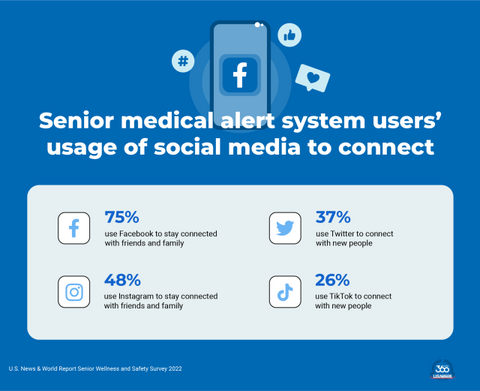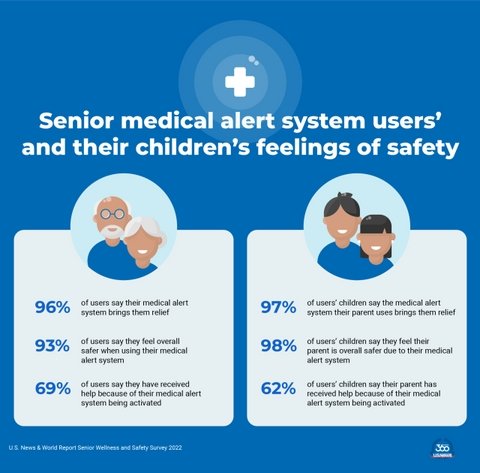In September 2022, U.S. News & World Report surveyed 1,000 U.S. adults to learn more about their feelings of safety associated with medical alert systems. Of the sample size surveyed, 40% of respondents are adults who either own a medical alert system for seniors and wear it or have it installed at home, and 60% have a parent who has a medical alert system for seniors, and their parent wears it or has it installed at home. We researched the perceived feelings of safety medical alert systems provide users and their children, seniors’ feelings of connectedness to their neighbors, how they prefer to interact with loved ones, and more.
Medical alert systems, also known as a personal emergency response system, serve two primary functions. The first is to provide users with assistance in emergency situations. The second is to provide users, their family and friends, and caregivers with the reassurance that help is available if and when it may be needed. In fact, the overwhelming majority of survey respondents (93%) say they feel safer using their medical alert system.
Both Seniors and Their Children Feel Reassured Using Medical Alert Systems

(USN&WR)
Making the decision to adopt a medical alert system can be a difficult one for senior adults. On one hand, some may feel embarrassed to wear a medical alert device due to a perceived stigma or feel that they simply do not need one. On the other hand, a medical alert system can provide peace of mind and a sense of security for seniors who wish to live independently and their families.
In fact, nearly all of the survey respondents who report using a medical alert system (96%), say that it brings them some relief or reassurance. More than two thirds (69%) of senior medical alert users surveyed say they have received help because of their medical alert system being activated.
Medical devices also provide peace of mind to the family, friends, and caregivers of seniors. Whether they are concerned about home safety, mobility issues, illness, or another issue, 98% of children of senior medical alert system users say they feel their parents are overall safer due to their device. What’s more, 62% of children of senior medical alert system users in the U.S. say that their parent has received help at least once because of their in-home monitoring system being activated.
Only 7% of U.S. survey respondents who use a medical alert system for seniors say they made that decision on their own. The rest were convinced by those they know and trust the most. The majority of survey respondents (36%) report that it was the influence of a spouse or significant other that helped them make this decision, followed by a physician or health care worker (22%), other relatives (19%), and friends (13%).
Most Seniors Can Rely on Their Neighbors for Support

(USN&WR)
In addition to family members, seniors who utilize medical alert devices frequently rely on their neighbors for assistance when in need. About 83% of U.S. senior medical alert users say they would feel comfortable reaching out to their neighbors in a medical emergency and 67% say their neighbor(s) sometimes or regularly help them.
One of the results of the COVID-19 pandemic was an increase in the number of people staying and working from home due to stay-at-home mandates aimed at reducing the frequency of physical contact and subsequent transmission of the virus between people. This extra time at home provided an opportunity for neighbors, including senior citizens, to get to know each other better, even from a safe distance. According to our survey results, 71% of senior medical alert users say they feel the pandemic has brought them closer with their neighbors.
Although the recent pandemic created opportunities to foster new relationships, there is still a portion of senior adults who feel disconnected from their neighbors. About 80% of senior medical alert users say they wish they knew their neighbor(s) better.
Seniors Value Tech to Stay Connected to Friends and Family

(USN&WR)
Being connected to a medical alert system is not the only way older Americans want to stay connected. Our survey found that 41% of U.S. senior medical alert users say they sometimes or often feel lonely. In-person visits are their preferred way to stay in touch with family and friends (32%), followed by phone calls (26%).
When the pandemic caused many families to forgo in-person visits with their loved ones, technology became a lifeline for many seniors. Two-thirds of U.S. adults aged 65 and older say they are internet users (75%), according to the Pew Research Center. And 61% of older adults owned a smartphone in 2021, up from 13% in 2012.

(USN&WR)
With all that access, it’s not surprising that our survey found seniors are also using video calls (17%), text messaging (12%) and social media (12%) to stay connected to their loved ones. When asked in a multiple-selection question which social media platform they prefer to stay connected with friends and family, 75% of senior medical alert users say Facebook is the most popular social media channel, followed by 48% for Instagram. About 37% prefer Twitter while 26% use TikTok to connect with new people.
A Growing Senior Population
The survey results are clear: An overwhelming majority of senior medical alert users and their children feel more secure knowing that they wear one or have it installed at home.
Whether you or your loved ones currently use a medical alert device, there’s a good possibility that someone you know will need one in the future. In the United States, the population aged 65 and older increased from 40 million in 2009 to 54 million in 2019, representing a 36% increase according to the Administration for Community Living, an operating division of the U.S Department of Health and Human Services. By 2040, there will be about 81 million seniors, more than twice as many as in 2000.
Methodology
Our 360 Reviews team used the third-party survey platform Pollfish to conduct a national survey of 1,000 U.S. adults who either own a medical alert system for seniors, and wear it or have it installed at home (40% of respondents) or have a parent who has a medical alert system for seniors, and their parent wears it or has it installed at home (60% of respondents). People identifying as female comprised 57% of respondents, while those identifying as male represented the remaining 43%. Responses were then weighted in order to reflect the current U.S. population by achieving equal distribution with known population characteristics


